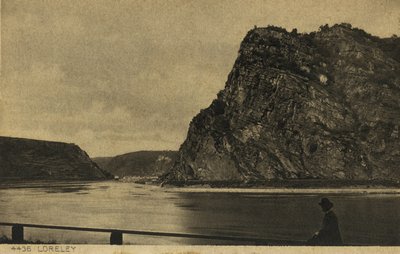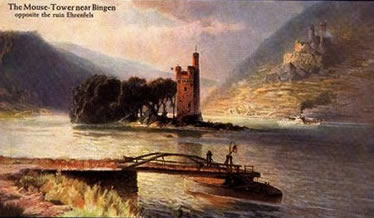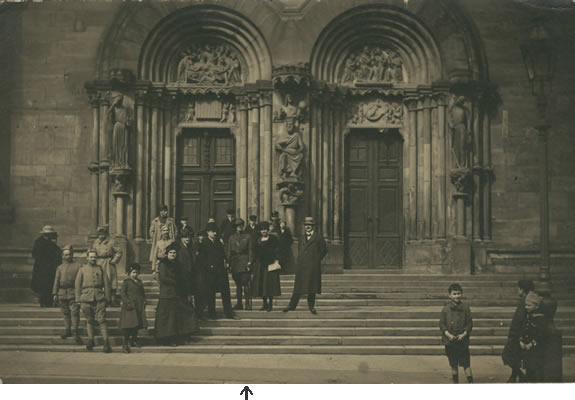Belgium and Germany
MARCH 1919
Saturday, 1st. ----------------
Sunday, 2nd. The clocks were put on an hour this morning, for the beginning of summer time. Drew 250 francs today, so that I can go on a trip to the Rhine tomorrow.
Monday, 3rd. Went over to the station and learned that the Cologne express goes at eleven o'clock. There was no time to get ready and get away today.
This afternoon in Charleroi demonstrations were held by the miners of the district demanding a working day of eight hours. At present they work ten.
Got a letter today addressed to "Lieut. P. E. Smythe, B.E.F., Bangalore, India". Both sides of it were covered entirely with various postal marks and re-address marks, etc. It had been chasing some Lieut. P. E. Smythe all through the British army. It was not mine, having come from South Africa and commencing "Dear Pat".
Tuesday, 4th. Got a leave pass to Brussels for two days, and two blank passes signed by the adjutant, which I can fill in according as I may require.
Wednesday, 5th. The Cologne Express was notified to arrive at 11.10a.m. I went over to the station early, but had to wait till nearly one before it arrived, and then there was a long wait there to enable the travellers to obtain lunch in Charleroi. With a little persuasion I managed to get the officer in charge of the train to give me a berth on board.
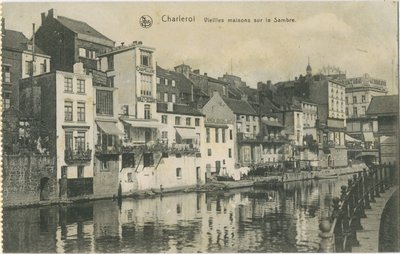
We got away about quarter past two, and travelled pretty slow as far as Namur. Thereafter the train followed the Meuse valley, which is rather pretty, the broad sluggish river with its banks dotted with villages and quaint old stone houses. Occasionally we passed along under low steep ivy-grown cliffs which hemmed in the valley and the river. Sometimes we would pass a manufacturing or mining town, with its red and black chimney-stacks, then more quaint little villages with their walls of grey and of white, and their red and black roofs. Darkness set in as we were nearing Liege. Turned into my bunk, but could not sleep for some time. Was still awake when we arrived at Aachen (Aix-la-Chapelle).
Thursday, 6th. Awake early, to find the train at Coln (Cologne). Went off to sleep again, as it was very early. Turned out at half-past six and went to the Officers' Club, which was established in the Ewige Lampe Hof (Ever-burning Lamp Hotel). Got a decent breakfast there for four marks, which, at the present rate of exchange, is equal to two francs, or 1/8 in English money. The face value of a mark is one shilling. German waiters are employed at the club, and a German was at the door selling the meal tickets. He tried to fool me over the change from a 5-franc note, thinking no doubt that I did not understand the money sufficiently to tell the difference. On one or two occasions later in the day he tried the same dodge. No doubt he is making a pile of money cheating those who were new to the place and were not too sure of the relative values of the different currencies.
The waiters were insipidly polite. In fact, they were servile. I should have liked them better if they had been a bit sullen, but no, they were typical Huns.
Having breakfasted, I went out with a Tommy Officer who was looking for his headquarters. Close to the Club, in a large open square, towered the majestic cathedral, one of the best, if not the best, in Europe. It was a fine sight, standing up like a protecting giant above the city, its twin spires pricking the sky.
Passing down the square and under the railway line, we came in sight of a broad sluggish river, the Rhine. The Rhine! Our goal through many weary months of hardship, misery, fear and discomfort. The goal that often seemed like a ghostly dream, so unreal and imaginative, so far away. The Rhine! The centre of our hopes, the mocker of our despairs. The prize that hung afar off, seemingly as unattainable as a star in the heavens, the prize that hung before the eyes of millions of bloody, grimy,
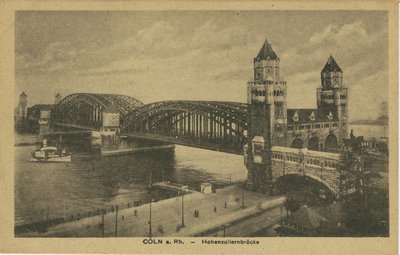 Hohenzollen Bridge
Hohenzollen Bridgesweating, shivering, vermin-infested men, who struggled mile after weary mile under their heavy burdens, who waded heartsore, footsore, and "fed-up" through endless quagmires, who endured the frightfulness of shellfire, and who fought on doggedly, cursing, praying, hoping, dreading, yearning, and always looking forward to the far-off and almost fictitious goal -- The Rhine. And now we are at the Rhine, and the war is over. Thank God!
On our right was the famous Hohenzollern Bridge, a dignified and imposing mass of steel network.
Farther upstream we could see the Hangebrucke, a large suspension bridge. The Rhine here was about quarter of a mile wide, flowing through a flat country.
We walked down along the river bank for two or three miles looking for the Tommy officer's headquarters. This was in the better class residential part of the city and contained some very fine houses. There were also some fine examples of artistic lamp-posts and decorative metal-work on houses.
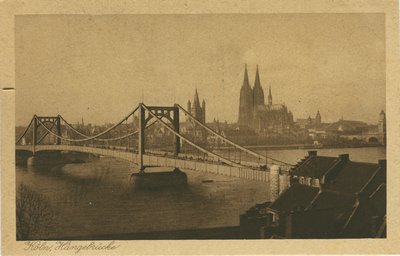 Hangebrucke Bridge
Hangebrucke Bridge
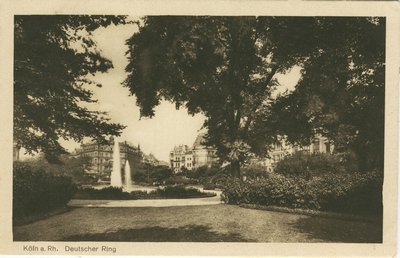 Deutscher Ring
Deutscher RingAfter making enquiries my friend discovered that the headquarters were not out this way at all, so we turned back, going a different way. We came along a lovely wide boulevard with rows of trees, garden patches, fountains, and pools along the centre.
It is called Deutscher Ring, and must look very beautiful in summer when the trees are all green and the flowers in bloom.At one spot there was a fine statue of the Kaiser on horseback, looking proud and triumphant, a striking contrast from the fugitive emperor as he is. I wanted to admire and talk about the beautiful and interesting things to be seen along the way, but my companion had no interest in them and persisted in talking about himself and his doings. He also persisted in walking all the way back instead of taking a tram. At last we found his headquarters, in a fine building with palm trees and statuary in the vestibule, and the Union Jack flying triumphantly above, seemingly saying to the vanquished enemy, "Deutschland, Deutschland unter alles!"
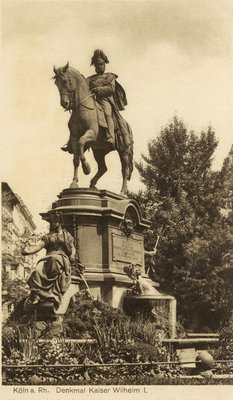 Kaiser William on Horseback
Kaiser William on HorsebackHaving reported himself, the Tommy officer came with me back to the club. By this time I was heartily tired of him, and determined to shake him off. Making financial business an excuse, I managed to get away from him, and went round to the Cashier. Changed most of my Belgian money into German, fifty francs being worth 97 marks. Went to the Billeting Officer, who was installed in the Dom Hof, and got a room in the Hamburger Hof, a nice quiet hotel near the Railway Station. A number of these hotels have been taken over, in whole or in part, by the military authorities, and have to provide free accommodation for officers.
My next move was to look through the cathedral. The stoutly columned interior is very grand and imposing, though somewhat lacking in beautiful details. The beautiful coloured-glass windows reminded me of the gorgeous plains of Picardy in all their summer splendour. There was an air of vastness and majesty about the place, the many tall beaded columns soaring away to the distant roof. There was an odour about the place like the pungent smell of damp moss-grown rocks. The smaller details, altars, chapels, pews, etc., were much the same as in most other cathedrals I've seen.
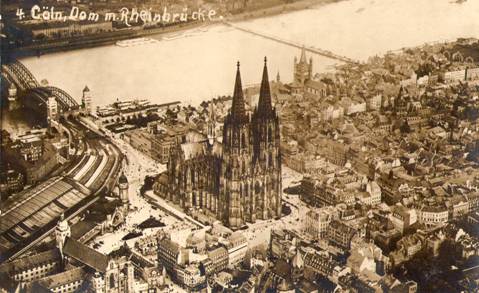 Cologne Cathedral
Cologne Cathedral
Went to the club for lunch, which cost 6 marks. The food is good, both in quality and quantity, being supplied by the E.F.C. It is almost impossible to get food anywhere else in the town, and what food they have got is very dear and poor in quality.
After lunch, I went to the Walraf-Ricartz Museum. In the Art Gallery part there are some very beautiful pictures, some of the finest being "The Goddess " a full-length portrait of Marie Louise, "The `travernden Juden (en Exile"), and a very striking picture portraying a fight between Michael and Satan for the body of Moses. Three little cherubs are shown bearing the body of Moses heavenwards, while Michael, with shield and flaming sword, is flying alongside and keeping back the black figure of Satan.
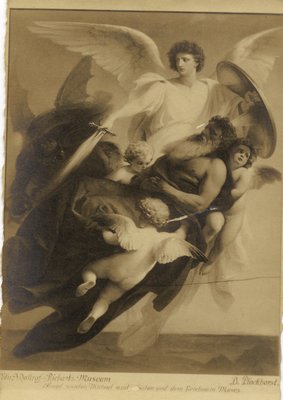
There were also some fine Rubens, and a very large collection of religious pictures in a grotesque style, probable very old. They are supposed to be very beautiful, but I did not care for them at all. Probably I do not understand art sufficiently to appreciate them at their true worth. The friends and devils shown in some of them are extremely hideous. In most of them the figures are very long and thin, and anything but graceful, while in others they are short and squat, and just as ungraceful. Another lot of very fine pictures were remarkable for the amount of small detail in them. There were other rooms containing pictures which were not particularly good, and did not appeal to me. Among these were some done in the modern style with broad splashes of brilliant colour, but to me they seemed failures. In one room there was a beautiful collection of pencil and charcoal sketches by Wilhelm Liebl. Some of these rough sketches were, in my opinion, more beautiful than the finished oil paintings of the same subjects.
Besides the pictures, there were many old Egyptian relics, such as one finds in every museum, a model of the ancient Roman Coln, from which the present-day city has its origin, and many small and dainty bottles, ancient pottery, and earthenware lamps like they used in Bible times.
Strolled down along the main street, "Hohenstrasse", a very narrow and crowded thoroughfare. Was saluted by all the Germans wearing uniform of any kind, such as postal, tramway, and municipal employees. This is one of the obligations imposed by our military authorities.
Went over the Hangebrucke, and was rewarded with some excellent views of the river, the city, and the magnificent Hohenzollernbrucke. Came back over the latter. It looks even more imposing upon close inspection, with its great arches of steel towering up above. One half of it accommodates a double track railway line, the other part being used for ordinary traffic, including double tramway line. Standing on the bridge and looking towards the city, the beautiful cathedral appeared behind the meshes of an intricate network of steel.
It rained a bit during the afternoon, and was rather cold. Strolled up to the Opernhaus (Opera House), which is a handsome, but not very beautiful, building, and along Hohenzollern Ring, which is a continuation of Deutcher Ring.
Dinner at the club was 8 marks, and was quite a respectable meal, but the place was so overcrowded that the serving was tiresomely slow. It took about an hour and a half to get through the meal. At last I got back to the hotel, very tired after all the day's walking about. All the Germans that I came in contact with were so intensely polite that one was rather inclined to despise them. If they had shown even one occasional glance of hostility or resentment, one could respect them for it, but when they cringe like a whipped cur, well ------.
Friday, 7th. Spent a restless night, haunted by grotesque and horrible dreams. Got up at half-past seven, and after breakfast at the club, went to the Opernhaus to book a seat for the Opera tonight, but found it closed. Took a tram out to the Zoologischer Garten. The tramways are free to soldiers of the army of occupation.
Strolled through the zoo, which is very interesting, and should be lovely in summer time. A poor lonely looking kangaroo looked very much out of place in this foreign land. Quite a large flock of flamingos walked about unconcernedly in a pretty little pond, despite the coldness of the weather. Many cages were empty, the occupants having been killed during the war on account of the shortage of food. The grounds are ample and well-appointed. There were some fine lions, tigers, leopards, etc., and a good collection of polar bears, the latter having an artificial rock-bound pond at their disposal. Above this, on the top of a rocky mound, were a number of cages containing eagles, condors, vultures etc. The last place I went into was a parrot house, which included among its inhabitants a large percentage of Australian natives. A large white cockatoo with blue eyes and sulphur crest stood on his perch looking stolidly indifferent to the folk who stopped to gaze at him. I put my finger through the meshes to try and make friends with him. At first he took no notice, then, seeing that I really meant it, he became very friendly and affectionate indeed. In fact, the ardent way in which he took to me made me think that he was not in the habit of being treated even decently. Poor wretch, he begged me, as plainly as though he had spoken the words, to take him away with me. He put one foot through the bars and gripped my hand firmly with it, then put the other foot through, and while clinging to my hand with both feet he put his head through and tried to squeeze his body through the bars. Every time I put my hand near him, he would cling to me and try to come through the bars of his prison. The look of appeal in that poor bird's eyes was enough to touch anyone's heart. I wanted to release him, to take him with me. I would have liked to have bought him if that had been possible. It hurt me to have to go and leave him, and to see the look of wistfulness and yearning in the intelligent eyes of that unhappy bird.
Before leaving the parrot house I stopped to try and make friends with a big grey parrot of a kind I've not seen before. He put his head up for me to scratch him, and looked very docile and friendly. Standing on one leg, he slowly raised the other as though to assist in the scratching. When he had got it up to the level of his head, with a rapid manoeuvre he grabbed my finger with his claws and held fast to it while he dug his great beak deep into the flesh. Treacherous beast! I'm sure it must have been a German parrot. The hole in my finger bled a treat, and I had to keep it swathed in a handkerchief.
Left the zoo and dashed after a tram just departing from the terminus. I caught it and jumped on to the footboard, but, being on the wrong side, could not get in to the car. There was nothing for it but to stand there till the car stopped. Suddenly I noticed another tram coming in the opposite direction. The lines here were extremely close together, so that the two cars must almost touch in passing, and there was nothing in the way of a recess that one might squeeze into. Both trams were travelling at full speed, and there was not a moment to spare for reflection. I jumped, landed in the middle of the track five yards in front of the oncoming tram, and got over the line just before it dashed past. It was lucky I kept my feet.
Walked back as far as the law-courts, a handsome building with an arc-shaped front, standing back behind an open space. Walking on, I saw something in the window of a house which caught my attention. It appeared to be a cut-out poster or picture of a hideous face like the cartoons one sees of mad Bolsheviks, thick grizzled beard and a mop of grizzled hair, and a horrible expression on the face. As I walked past looking at it in wonder at the very hideousness of it, the supposed picture suddenly started back violently as it caught sight of me, the eyes bulged out of their sockets and stared as though I were some frightful apparition. This made the face look more horrible and unearthly than ever. I was greatly astonished, and it made one feel uncomfortable to be the object of that ghastly maniacal stare. Obviously the fellow was a maniac, possibly a German soldier gone mad at the war and filled with sudden terror at sight of anyone in khaki. I looked back as I went on, and the awful face kept moving around the window to keep me in view, until the foliage of a tree came between.
I wondered if there might be a lunatic asylum there, but the buildings all looked like private houses or residential flats. While I stood looking about, wondering, a woman spoke to me in English, asking if I wanted to know the way somewhere. I explained about the madman, and then she asked if I were a Canadian or American. Then we got talking about things, and I learned that she was an English lady married to a German, and had been living at Cologne since before the war. She invited me to her home, so I went along with her. She had her two little children with her, out for a walk.
Her home was a very comfortable and nicely-furnished flat in Aducht Strasse. Her husband is a small and rather emaciated looking man, intensely polite. He has travelled a great deal, and was in the engineering trade in England for some years. His firm sent him to Germany just before the war began. The German branch has since closed down. Mrs. Heinze was very interested in me, and wanted to know all about everything. She had had a trying time during the war, what with the scarcity and poor quality of food, and the many indignities and hardships suffered on account of being English. She made me accept a couple of bottles of genuine eau-de-Cologne, made at the pre-war strength and quality. Before I left, she asked me to come to tea in the afternoon. On going back I noticed that the blind was down over the window where I had seen the awful face.
Went to the Opernhaus, but found it still closed. Did not wait to have lunch, as it was late, but went straight round to the Cashier's office. It was crowded, and I couldn't spare the time to wait. Got a waiter at the club to pack some lunch for three, 18 marks worth. I gave him 20 marks as I thought, but found afterwards that I had given him 20 francs, worth almost twice as much.
When I arrived at Mrs. Heinze's place, they were delighted to get the sandwiches, especially the children, for it was such a treat after the food they had been getting. I tried some of their bread, which is a very dark brown, and seems to consist mostly of bran, judging by the taste. Mrs. Heinze showed me some of the tea they had been getting until recently. It looked like various kinds of grass seeds mixed together. She gave me some of it to keep as a souvenir. Herr Heinze teaches English to make a living of some sort. He knows the grammar well, but his pronunciation is very poor. His wife told me that, seeing other men making big fortunes out of war enterprises, he decided to speculate also, invested all his money, and lost the lot of it, 200,000 marks (about £10,000).
Came away about half-past five, and returned to the club. Remembering the number of the waiter who had made up the lunch, I asked for him, but he was nowhere to be found. After a time I was told that he was away ill, but would be back at dinnertime. However, when I came in to dinner he was not there, so I saw the head waiter and he told one of the others to go around to waiter 24's place and get the money from him, and let me have it in the morning.
After dinner I strolled over the Hohen-zollernbrucke, which looked even more grand and imposing in the semi-darkness. Walked up along the north bank, whence a pretty view could be had. The many twinkling lights of the farther shore were reflected like strings of glowing jewels in the sluggish water. The great twin-spired Dom and her smaller sister, St. Martinskirche, stood up black against the darkening sky. Came back over the Hangebrucke. The streets of the city were almost deserted, it being martial law that all civilians must be indoors by half past eight.
Saturday, 8th. Met Cpn. Fewtrell and Sexton, of the 6th. F.E., at breakfast this morning. They have just arrived at Cologne to do the Rhine trip. Waiter 24 was still away sick (?), and the waiter who was told off to see him and get the money was also absent with illness(!) Obviously they were all working together to help one another to defraud the hated English at every opportunity. I found a Tommy serjeant and explained the case to him. He took the first waiter he came across and told him to pay me back the 20 marks which I had overpaid. The fellow did so without hesitation, but looked thunder.
Went to the Cashier and drew 200 marks (£3-16-4). Missed the 9.10a.m. train to Mainz, and there were no more after that till half past three. Commenced writing a letter to Dorothy, but only got one paragraph written. Strolled down Hohen-strasse, and around by the Rathaus (Town Hall) and St. Martinskirche.
Early this afternoon I took the opportunity to go up the cathedral tower. Quite a number, mostly Tommies, were going up, and a German guide took us. We ascended a long spiral staircase, going up and up and round and round, and getting excessively giddy in doing so. At various points on the way up we could look out through small windows or from galleries. Some of these galleries were in the midst of a forest of ornamentation, on the outer wall of the structure. Fine views could be had from them, the town and river appearing through a network of stone formed by the many minarets, the great stone steeples, and the wealth of small ornamental masonry.
Higher up we came to a great square chamber containing the bells, which were of various sizes, some of them very large and probably weighing many tons. More galleries and corridors and winding stairways till we came to a round chamber in one of the steeples. Then up again, farther and farther, to the highest point where visitors are allowed. This was at the top of the square part of the steeple, and from here the conic spire rose skywards, accompanied by the twin over opposite. We were on a gallery which encircled the steeple. The views obtainable from here were glorious. The city lay spread out like a relief map at our feet, streets radiating and circling in all directions. The body of the cathedral, cross-shaped, lay far below, its wealth of ornament now scarcely discernible. St. Martinskirche, with its square tower topped with four minarets, was the tallest other building to be seen. The finest sight of all was the winding ribbon of silver that lay snake-like across the plain, gleaming white in the light of the sun, broken at several points by the black masses of the various bridges.
We descended by a different route from the way we went up. On the way down we came through a large square chamber which contained the works of the clock and a number of large tapestries, whose age and historical worth seemed to be of more interest than their artistic merit. Descending farther again we came to an interior gallery whence one could look down on the pews and the altar. They seemed so far below. Even the great organ seemed a long way down.
Coming down the last long winding flights of stairs, reeling with dizziness, I left the building and returned to the Hamburger Hof. Collected my few belongings and caught the half-past three express to Mainz. The railways are free to all troops of the army of occupation.
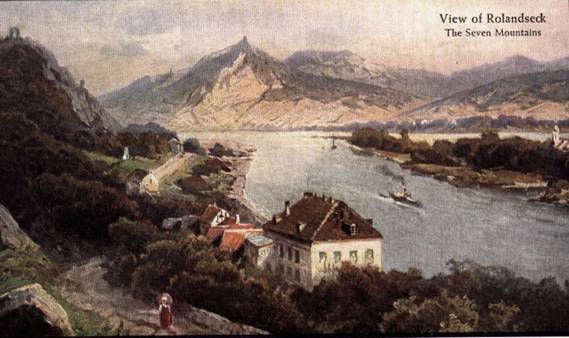
The journey was a very interesting one, the railway line for the greater part of the way following along the bank of the river. Being a fast train, one could only get a fleeting glimpse of many of the most interesting places. I was at the side nearest the river, and had a clear unbroken view of the broad stream and the rugged mountainous banks opposite, but could see little or nothing of the side we were travelling on. After passing Bonn, the university town, we soon came in sight of the Siebengebirge (Seven Mountains), which rose majestically from the farther bank of the Rhine. On the summit of one of the highest of these mountains the dignified ruins of Drackenfels stood up boldly, dominating the surrounding valleys. The scenery hereabouts was very grand and imposing, and afforded an ever-changing panorama as the train swept on towards Rolandseck.
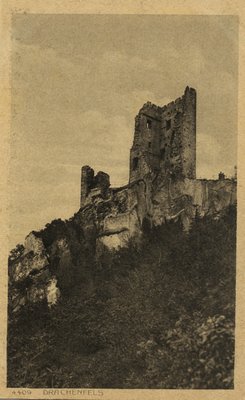
Drackenfels
From here on the northern bank of the river became very rugged and mountainous. Towns and villages were dotted along the riverside, tucked cosily under the mountains and occupying small stretches of level land between the water's edge and the steep rocky slopes. The sides of the mountains were cultivated, mostly with vineyards, wherever possible. The line lay along the foot of steep-rising slopes, until we arrived at Andernach. We then entered upon a broad flat plain, and soon the railway left the river bank to take a short cut across the open country. Crossing the River Mozelle we entered Coblenz, the centre of the Rhine bridgehead held by the American forces. On a low flat-topped hill across the river, an extensive rambling castle of modern appearance, Ehrenbreitstein by name, sat lazily overlooking the water.
Passing Coblenz, the way again lay along the foot of precipitous mountain banks, close to the water's edge. The river took a couple of sudden sharp turns, describing a letter "S". This afforded some very excellent views up the Rhine, which lay like a broad sheet of silver between the mountains. Snuggling under the hills on the right could be seen the pretty little town of Boppard, and in the distance the rugged heights merged softly into the grey haze.
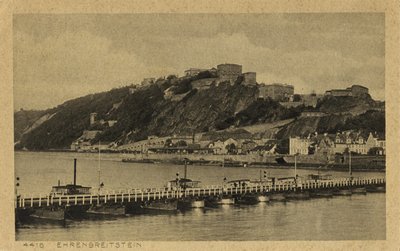 Ehrenbreitstein
Ehrenbreitstein
From Coblenz to Bingen the country we passed through was very mountainous, and many castles, some old and in ruins, others well preserved and still inhabited, stood proudly upon their lofty heights looking down upon the famous old river. The Lorelei Felsen, a great promontory of solid rock, rose up sheer from the water's edge near the town of St. Goar.
We passed a number of small islands, mostly covered with leafless trees and rank-looking grass. Passing under a steep wooded slope, some of the buttresses and turrets of Rheinstein castle could be seen towering up above. As we approached Bingen, the National-Denksmal (National Monument) could just be discerned in the growing dusk.
It stood on a hill across the river. Crossing a small tributary called the Nake we came into the town of Bingen --- "Bingen on the Rhine". It brought back old memories of childhood's days with the familiar words of the old song, worn threadbare with frequent repetition:
"When the war is o'er we'll part no more
At Bingen on the Rhine". Strange that one should come from the other side of the world and incidentally visit the town of that old song which dear old Mum used as a lullaby for us when we were children.
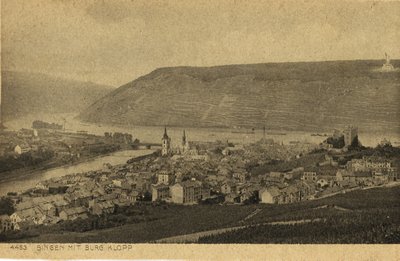 Bingen mit Burg - Germany
Bingen mit Burg - Germany
We were delayed here for some time, and darkness had set in before the train moved on again. In my compartment were a Tommy R.A.F. officer and a 4th. Div. Aussie officer, the latter being on 75 days' leave to south of France, Italy, and the Rhine, which he had taken in lieu of the six month's leave to Australia granted to 1914 men. The three of us being on the Rhine tour, we decided to go together as far as our plans and arrangements allowed.
It was half past seven when the train arrived at Mainz (Mayence), which is the hub of the French bridgehead across the Rhine. We took a train to Wiesbaden, a popular spa resort, which lies some miles north of the river. There was no accommodation available at the Cercle des Officiers (Officers' Club), so we got rooms at the Hotel Rose, a magnificent modern hydro. The French authorities here have not a system like the English have at Cologne, whereby accommodation is provided for officers at the expense of Germany.
We had a belated dinner at the club, which is a very nicely furnished place, formerly the Palast Hotel. It is much more comfortable and luxuriant than the Ewige Lampe at Cologne. There is an air of coolness and tranquillity about the large carpeted rooms, fresh as a summer garden with palms all around the walls.
Having dined, we strolled up to the Thurhaus, but could not see much of it by night. So we took a walk along the main street of the town. A lot of French soldiers were walking out with German girls, and seemed quite at home. We also met French officers out walking with frauleins. This surprised me very much indeed, for I had thought that the hatred felt by the French for the Huns was so great as to preclude any possibility of fraternising. We came upon some girls who appeared to be in difficulties with a motor car. They were English girls in the French army as motor drivers. They told us that the car did not belong to them. It was a small tender left there for the night by someone, and the mischievous imps had taken into their heads to take the car and go for a spin before bedtime. However, upon the 4th, Div. officer opening the engine-case, it transpired that the sparking apparatus had been locked by the owner. So the girls had to go home disappointed.
Tired after the day's journey, we went to our rooms. They are in pairs, with a bathroom attached to each pair. The whole place is an elegant example of modern luxury. Rich soft carpets cover the floors. The building is warmed by gas radiators. Each room contains a lounge and a writing table besides the ordinary bedroom suite, which is itself the last word in elegance and comfort. The bathroom wall and the bath are of marble, shelves of glass, and fittings complete to the smallest details. It makes one feel like a young millionaire to be staying in such a place.
Sunday, 9th. Indulged in a hot mineral-water bath this morning. This water is supposed to cure any and every ailment to which humanity is subject.
After breakfast at the club, we strolled around the town, which is a fine modern place, and very clean. The buildings are all done in ornamental style. There are some broad boulevards with avenues along the centre. A peculiar church attracted our attention. It resembled somewhat an Egyptian mosque, with its dome and minarets. Though only a small building, it was quite handsome and interesting. Farther round we came into a square, which contained, among other buildings, the Rathaus and Marktkirche, the latter a tall handsome building with many spires.
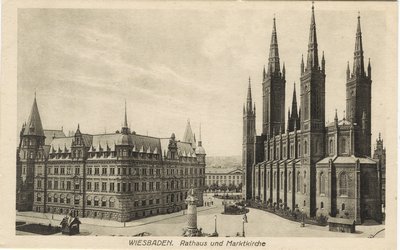 Wiesbaden - Rathaus and Marktkirche
Wiesbaden - Rathaus and MarktkircheIt is made of red brick, which produces rather an unusual effect. Coming back to the Kurhaus, we went through its grounds. They contained a very nice little artificial lake. Collected in one corner of this lake were hundreds of goldfish. They looked well fed and lazy, and seemed scarcely to have enough energy to frisk about. There were also several small brown-and-blue ducks, who amused themselves occasionally by swimming in among the fish and making playful pecks at them. In front of the Kurhaus was a beautifully laid out garden with sweet little ponds and fountains. It must look beautiful in summer when all the flowers are in bloom.
Close by here we found the Opernhaus, a really fine building adorned with beautiful statuary. On either side near the top was a group with a proud and beautiful female figure standing in a chariot driving several plunging spirited steeds. Behind the Opernhaus were more park grounds with lakes and fountains.
There are many pretty little garden patches about the town. It is about the cleanest and nicest place I've seen in Europe. One must at best give the Germans credit for the clean healthy condition of their towns.
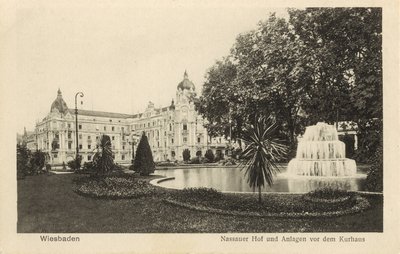 Nassauer Hotel - Wiesbaden (and Garden)
Nassauer Hotel - Wiesbaden (and Garden)
We had lunch at the Cercle des Officiers. As I was going on to Strasburg and the others were not, I took the train back to Mainz, the 4th. Division officer coming with me that far.
Left Mainz by the 2p.m. train to Strasburg. We passed flat country, cultivated with vineyards, and orchards. For a short distance we followed the course of the river, then left it and moved across the open plains to Ludwigshafen, a fair-sized town which had been raided several times by our aeroplanes during the war. Then came more flat country, with vineyards nearly everywhere. Away over to the right a range of mountains could be seen, blue in the haze. This range gradually approached the railway till we arrived at Neustadt, a decent-looking town at the foot of a small mountain. After a little delay here we moved on westwards again. The hills hereabouts seemed to form a spur running out from the range over to the right. At the end of this spur, on the top of a detached isolated hill, stood an old lovely-looking castle, like a sentinel guarding the approach to the mountain.
We entered another wide level plain, and the range over to the right became more rugged and mountainous, rising abrupt from the flat country. They are the Haardt Mountains. Towns and villages could be seen clustered along the foot of them, many church spires silhouetted against the dark wooded slopes. Away to the left the land was flat as far as the eye could see.
At Wissemburg we were delayed for some time, and darkness had set in by the time the train moved on.
It was half past seven when the train arrived at Strasburg (the Germans spell it "Strassburg" and the French "Strasbourg"). Enquired the whereabouts of the Cercle des Officiers, and was told to go to the Place Broglie. Took a tram there, found the club, and booked a room for two nights. They would not accept German or Belgian money at the club, but fortunately I had three francs in French money, which was just enough to pay for dinner.
After having dined, I went for a short stroll about the town, but, feeling rather tired, I returned to the club and went to bed.
Monday, 10th. Found the offices of the Ministè re des Finances, and changed 100 marks for 50 francs. Petit dejeuner at the club consisted of dry bread-rolls and coffee. After that I found the famous cathedral, which is a fine majestic old building. There are the usual arched doorways and their wealth of sculpture and ornament. The fore end is similar in style to the Dom at Cologne, except that it has never been completed, only one of the twin steeples having been built. This steeple is not built solid, but can be seen through as though it were made of massive stone lacework.
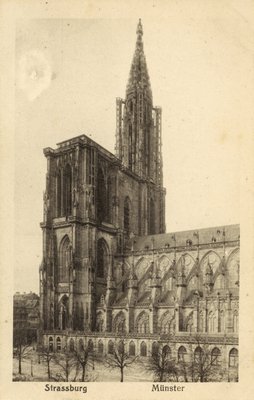
Strasbourg Cathedral
Went inside and looked through a part of the interior. The building is evidently showing signs of collapse, for in many places there are immense wooden girders supporting it. Practically the entire space under the steeple is occupied with these huge pillars of wood, several feet in thickness. They are so close together that there is scarcely room for a man to squeeze between them. This area is boarded up.
I was eager to see the wonderful clock which I had so often read about in times past. Found it near the side entrance. It is an even greater wonder than I had anticipated. The number of different things that are worked and indicated by one set of mechanism is really marvellous. The main body of the clock is divided into several discs, platforms, etc. First there is a perpetual calendar, showing days, months, and years, and religious feasts, etc., though occurring in different dates each year. Above this is a platform upon which is a small figure driving a chariot. Each day of the week is represented by a different figure. They move round the platform at midnight, when the chariot representing the passing day goes through an opening into the body of the clock, the chariot for the coming day advancing through an opening at the opposite side. Immediately above this platform is the ordinary hour-and-minute clock dial. It has two sets of hands, a gilt pair showing the mean time, and a steel pair showing the time in actual use by the community (French standard time). There is about half an hour's discrepancy. Sitting on supports on either side of the dial are two genii. The one on the right is holding an hour-glass and he reverses it at every hour. The other has a gong and a striker, and he strikes the first note of every quarter, which consists of two notes, the second being struck by the figures of the Four Ages, moving on a platform higher up. Of course the two notes are sounded twice for the half hour, and three times for the three-quarters.
Next above comes the planetary system. The planets are shown by balls of various sizes according to the planet, and these revolve around a central sphere which represents the sun. The system is surrounded by a circular band on which the signs of the Zodiac are shown. Just above the planetary system there is a globe which depicts the current phase of the moon. It is gilt on one side and black on the other, and moves on its axis to show more or less of the gilt side according to the amount of the moon visible in the sky.
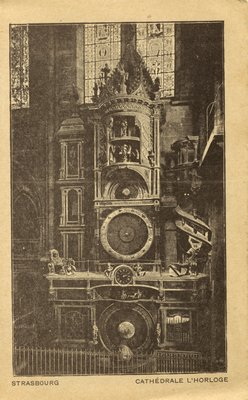
Strasbourg Cathedral clock
Above the moon globe there is a small platform with openings at either end into the body of the clock. At the back of the centre of this platform stands the figure of Death, a cloaked skeleton, holding a scythe in one hand. In the other hand he holds a striker with which he strikes the hours on a gong just in front of him. The Four Ages pass before him at the quarter-hours, and strike the second note of the quarter on the gong. At quarter past the hour the figure of Childhood, the First Age, walks solemnly up to the gong, strikes the second note of the quarter, then walks on and goes through the opening on the left. At half-past, the figure of youth walks up and strikes the two second notes, and goes on. At quarter to the hour the figure of Manhood comes forward and strikes the three second notes with a sword. At the hour, the figure of Old Age, round-shouldered and feeble, advances slowly and strikes the four second notes with a long rod he carries as a staff, and then moves on through the opening at the left.
Higher up there is another platform, on which, every noon and midnight, figures representing the Twelve Apostles pass in solemn procession before the figure of Christ, which stands at the back of the centre of the platform with one hand upraised, and holding a cross in the other. During this procession a large rooster standing on a support at the top left-hand side of the clock flaps his wings and crows three times.
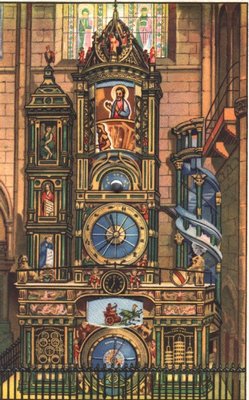
Strasbourg Cathedral clock
At the bottom and in front of the main body of the clock there is a large globe map of the stars. On the left of the Perpetual Calendar there is an Ecclesiastical Compute. It has a number of dials, but I don't know what it is that they indicate. On the right is another arrangement of dials with balls representing the sun and moon. It gives the "solar and lunar equations for the reduction of the mean geometric ascension and declension of the sun and moon at true times and places", whatever that means.
Truly it is a wonderful clock. The whole concern stands over twenty feet high, and is a very impressive piece of machinery, though not particularly beautiful in appearance. Various traditions have sprung up in connection with this clock and the two which preceded it, the most notable being of the maker whose eyes were burned out to prevent the possibility of any other town having such a clock as that at Strasburg, and who beguiled his captors to take him to the clock to remedy a fictitious defect, and when there destroyed a vital part of the mechanism, thus rendering the clock useless. Even now the Alsatians have superstitious beliefs about it, for they say that at the end of each year, when the mechanism is run down, it winds itself up miraculously at midnight on New Year's Eve.
Stayed and watched all the quarters strike, also the hour at eleven o'clock. Decided to go up the tower while awaiting noon. Climbed a long spiral stairway to a broad platform which is the base for the intended tower and steeple that have never been built. The existing steeple towered up skywards hard by. Some fine views of the town could be had from here. The protestant chapel, a Garnisonkirche, was the most prominent building visible. Much of this part of the cathedral has suffered from the effects of the weather. Many of the stone ornaments are crumbling away, and some have almost entirely disappeared. A gang of labourers are kept busy repairing defective portions and replacing worn stones with new ones.
Obtained admission to the tower and negotiated another soaring spiral stairway right to the foot of the magnificent spire, whose beautiful openwork masonry rose grandly overhead and pierced the sky. Far away below, the houses and streets looked like beehives and ant-tracks. There is a gallery around the base of the spire, with a small projecting platform at each corner. These platforms formed the summit of four buttresses, which evidently had been intended to support minarets, but these had never been added. This lofty position afforded an excellent panorama of the city, but one could not see beyond as the air was so hazy.
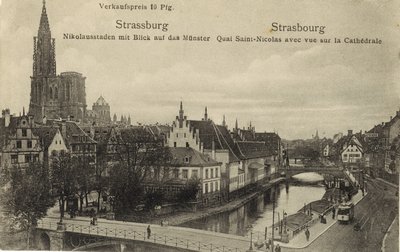 Strasburg Quai Saint Nicholas and Cathedral
Strasburg Quai Saint Nicholas and Cathedral
Came down in good time to see the clock strike twelve. Got a good position from where everything could be seen clearly. The space in front of the clock was crowded with people half an hour before the time to strike. A few minutes before twelve a hush fell upon the gathering as they waited expectantly for the midday demonstration.
Then it began. The genie on the right reversed his hourglass, while the other genie began to strike the four notes of the fourth quarter, alternated by the four notes struck by the figure of Old Age on the platform higher up. Then the figure of Death solemnly tolled twelve on the gong before him. As the last note was struck, the procession of the Apostles began. Each of the twelve figures came separately and moved along the platform till opposite the figure of Christ, where he stopped, turned to his right, and bowed, while the figure of Christ lowered his upright hand upon the worshipping disciple's head. The latter then turned and moved away, disappearing through the opening on the left. During the procession, the cock flapped his wings lazily and emitted a queer noise somewhat like an early morning crow. This he did three times. The whole demonstration took about five minutes.
When we came out there was a photographer outside with his camera, so I got him to take my photo standing before the side entrance. There were a few other people about, and I overheard one Alsatienne say to her husband, "Je vais avoir pris ma photographie à coté de cet Américan." ("I am going to be taken alongside of this American.") The people of Strasburg took me for an American. Many of them had never heard of Australia, and those who had done so thought that it was a part of America. Some of them would ask me about America, and when I said that I was an Australian they replied, "C'est la même chose, n'est-ce-pas?" [It's the same thing, is it not?]
I paid for half a dozen postcard photos and arranged for them to be sent on to Charleroi, as they could not be done before I leave here.
After lunch at the club, I came out to look around the city. The people stared at me as though I were a strange animal from the zoo. Probably it was the first time an Aussie hat had made an appearance in their city. Old people, children, and young women would stop and gaze in wonder as I went past. It made one feel uncomfortable to be the object of so much curious attention.
From Kléber Place, which has a monument to General Kléber, I found a way down to the canal which runs through this part of the city. There were here a number of barges moored to the bank, and in them were a lot of women washing clothes in the canal. Strolled along the canal as far as the Garnisonkirche, which is quite a handsome edifice in its own way.
From there I came up to the Kléber Place, a garden square surrounded by government buildings, the most imposing of which is the Kaiserpalast, or Imperial Palace, build by William Hohenzollern for his own special use. In the square was the stone base of a monument from which the Kaiser's statue had been torn down and destroyed by the citizens of Strasburg since the French reoccupied Alsace, about three months ago.
Continued by a circuitous route around the city, passing a quaint old church and the Jewish synagogue. Came back to Place Kléber, and walked about the town for awhile. Occasionally one met girls and old women in the Alsatian national costume, which is very picturesque and interesting, a huge black bow fastened to the back of the head being the chief feature.
Generally speaking the girls of Strasburg strike me as being the finest-looking of any town I've seen. They look so fresh and healthy and clear-complexioned, and are quite natural both in their appearance and manners. I noticed only one girl with paint on her face. What a contrast from Belgian or French, or even English cities! It is a rare thing to see a girl walking alone, and as for a young man and woman walking out together, except married couples, the very idea is unthinkable to Alsatians! Strasburg also appeared devoid of the human parasites so much in evidence in most continental towns. This is a very pleasing feature after Charleroi and Cologne.
Went through the cathedral again, as I had not looked over the interior properly before. It is magnificent, and though not so grand as the interior of the Cologne cathedral, it is much more interesting and picturesque, with its wealth of sculpture, its beautiful windows and rosaces. The Column of Angels is a notable feature. It is a tall stone column surrounded by stone figures of angels along its whole height.
Went back to club to rest awhile before dinner, being tired after so much walking. Spent the evening at a cinema to pass the time.
Tuesday, 11th. Slept in to about nine o'clock. Stayed for lunch at the club, and then caught the 12.15p.m. express to Mainz. We passed a fringe of the Vosges Mountains on the way. The country hereabouts was thickly wooded, but later we came out into the plain level country with its endless miles of vineyards and orchards.
Arrived at Mainz about 5p.m. Went to the Cercle des Officiers, found the Town Major and got a room at the Altmunster Hof. Strolled down town, but did not find it particularly interesting. A lovely boulevard runs from near the railway station down to the river.
Dined at the club. Had intended to go to the Opera, but found that I was too late for it. Walked around a few of the chief thoroughfares but did not find anything of unusual interest, so returned to the hotel.
Wednesday, 12th. After a petit dejeuner of dry toast and coffee, I took a tram to Wiesbaden and proceeded to the Nerotal, a wooded height north of the town. The way lay along a valley which had been made into a beautiful park, with garden patches here and there and a sweet little brooklet coming down the valley and making tiny waterfalls where it tumbled over the boulders. It was a glorious morning, the sun glowing warmly and brightly over the landscape, and it made walking a pleasure. The park-valley was traversed by gravel walks and interspersed with clumps of evergreen trees.
Arrived at the foot of the Neroberg, a high hill whose sides are thickly wooded. There was a toothed railway up the side of it, the carriages for which are built on an incline. The seats are one above the other like the steps of a stairway. The railway appeared not to be in use at present, but there was a steep winding footpath ascending the Neroberg near by. I climbed up by this path, resting occasionally on some of the seats conveniently provided for the purpose. A fine modern hotel crowned the summit of the height, and from here one could look down on the city, spread out at the foot of the hill, the tall slender spires of the Marktkirche pointing upward from the centre.
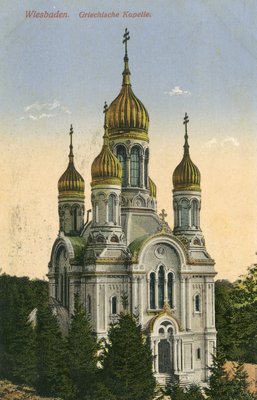
Griechschische Kapelle
Going on down the other side, I came to a cleared space among the trees, in the centre of which is situated the Griechschische Kapelle, a square turreted church beautifully built of white marble with fluted domes of gold. These domes are of real gold, and must have cost a fortune. It was not open, so I was unable to see the interior.
Came down to Wiesbaden. Bought a couple of dainty little souvenirs, chic little porcelain maidens garbed in bathing costumes made of coloured net.
Took the tram back to Mainz. There was not time to wait for lunch, so I got my things from the hotel and hurried to the station, arriving there just in time to catch the 12.15p.m. to Cologne. It was a slow train, stopping at every station. I was glad of that, for it afforded a better opportunity for seeing the places of interest and beauty along the Rhine. I had with me a picture-map of the course of the river between Mainz and Cologne, and this enabled me to pick out each place by name as we came along. I jotted down notes all the way, so that I should be able afterwards to write up a full account of the trip.
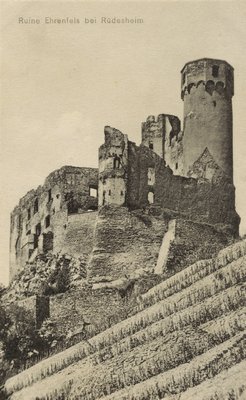
Rudesheim
At first we came through flat country with nothing much of special interest until we approached the Rhine near Rudesheim, a fair-sized town on the opposite side of the river. It looked very picturesque with its white walls and black roofs interspersed with tall church steeples.
Arriving at Bingen, the great National Denkmal could be seen crowning the summit of a steep hill called the Niederwald. The monument is a great stone structure adorned with beautiful bronze statuary, and having a large bronze figure of Germania seated proudly at the top in an attitude of triumph. This figure itself is thirty feet high. It is so large that the labourer who screwed the parts together in the interior crept out through the joint of the hand. The monument was created to commemorate Germany's success in the war of 1870.
The sides of the Niederwald and neighbouring hills are terraced with stone walls so that every available square-yard of earth may be cultivated. It reminds me a little of Malta in this respect. At the lower end of the Niederwald, built on a great rock jutting out of the hillside, stands the square-built castle of Ehrenfels with its old crumbling tower.
There was a fair amount of traffic on the river here, tugs, launches, steamers, and steam barges, some going up and some down.
A hill rises up behind Bingen, and on its summit stands Burg Klopp, which looks to be in good condition, and inhabited.

Rheinstein Castle
Leaving Bingen, with its neat little garden patches, we crossed the Nahe, and then the line ran along under high mountainous banks close to the water's edge. Across the river the mountains rose just as steeply to a high plateau. On an island in the river was a small fortification called the Mauseturm. In a sheltered cove across the water, the little town of Assmanshausen snuggled cosily beneath the protecting heights.
Passing under a steep cliff, the turrets and towers of Rheinstein Castle could be seen frowning overhead, only a small part of it visible over the rock on which it is built. A little farther on, the old castle of Falkenburg, with its many turrets and towers, stood up boldly upon a projecting rock just above the railway. It was partly grown over with ivy, and looked very picturesque.
The mountains on either side of the river were now becoming more rocky and tree-clad, with fewer patches of cultivation. There was an air of wild grandeur about the scenery. Burg Sooneck, a modern-looking castle, towered proudly aloft at the top of a rocky height.
A steamer flying the American flag and packed full of Yankee soldiers passed up the river, evidently on a tour.
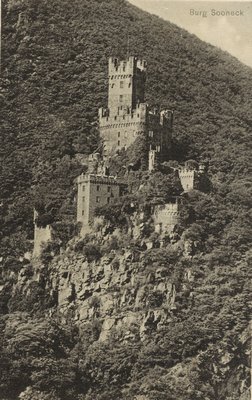
Burg Sooneck
Our next stop was the little town of Nieder-Heimbach, with its picturesque old castle ruins, all ivy-grown. In the mouth of a beautiful valley on the opposite side of the river, the pretty little town of Lorch reposed peacefully, its houses clustered together by the shore and extending back some distance between the steep rugged sides of the valley.
Passing under a rocky height on which could be seen the crumbling ruins of Furstenberg, almost entirely fallen to pieces, we arrived at Bacharach, an interesting township tucked away under precipitous mountain sides. The river is a little narrower here, and just across it a lofty mountain rises steeply to the sky. Just above the town the last crumbling remnants of a one-time castle can be seen, and on another knoll are the ruins of an old church, the Wernerkapelle, only the walls of which remain. The ruins of Stahleck castle overlook the town from a commanding height.
Moving on from Bacharach, the Pfalz could be seen squatting like a lazy toad on an island in midstream. It is a small castle, apparently well preserved, and probably still inhabited. These island castles were built by robber barons in bygone days for the purpose of collecting toll from vessels passing up and down the river. They carried on their lawless work successfully in defiance of their Government. Across the river the square-looking ruins of Burg Gutenfels look down from their elevated position upon the town of Caub, whose houses grow like flowers upon a narrow strip of level land along the shore.
The next town was Oberwesel, situated on a flat corner of land at the foot of a mountain with steep rocky sides. The imposing castle of Schonburg towered up aloft from the brow of the height. On our side the castle is quite in ruins, but the other side, with its round tower, is more intact. A little farther down, the river took a sharp bend to the right, and going around this bend enabled one to have an excellent view straight up the Rhine with its rugged mountainous banks. Oberwesel, with the Schonburg towering above it, could be seen in the distance.
The stream turned to the left again, to continue its course westwards, and in the hollow of this bend, where the hillsides formed a rock promontory, the train entered a tunnel, emerging later at a spot which commanded a beautiful view downstream. Across the water a mountain of solid rock rose up sheer from the water's edge. It is called Loreley-Felsen, and is associated with many old legends. It is affirmed that the deep bend of the river just above the Loreley gives rise to an extraordinary echo which can repeat itself twelve times. In the distance could be seen the village of St. Goarshausen lying along the shore on the right bank, and towering above it a wooded height capped by an old castle, Burg Katz, whose huge round tower dominates the surrounding landscape. The ancient stronghold is crumbling to ruin, but it has a newer and more modern portion build on to it, which produces an almost ludicrous affect. A distant rugged mountain with terraced sides formed a pleasing background to the picture.
Going through another tunnel, we arrived at St. Goar, above which are the extensive ruins of Rheinfels, all crumbling to decay. Farther on, the ruins of Maus castle stood boldly forth on a spur of a steep hill. It appeared to be in a fairly well-preserved condition. From here down to Salzig the banks of the river on either side became very high and precipitous. Opposite to Salzig the country is a mass of rocky heights. The Feindlichen Bruder (Hostile Brothers), castle Sternberrg and Liebenstein, sit on two opposing hilltops close to each other. They are both in ruins. Below them at the water's edge is the Kloster Bornhofen, a convent, where a deep rugged valley opens out from the Rhine.
A little farther down we came to Boppard. The slopes here on either side are less steep and rocky than heretofore, and are closely cultivated with vineyards and orchards. Just beyond Boppard the river described a sweeping circular bend around to the right, then back again to the left. In the hollow of the bend on the northern shore reposed the little grey town of Liebeneck, with its castle of the same name standing on the hill above.
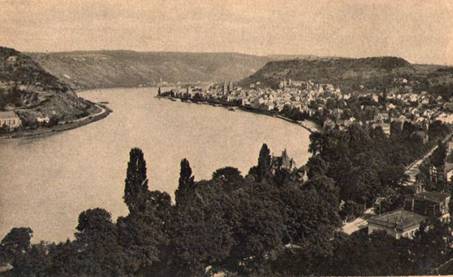 Boppard
Boppard
Beyond the double bend, the houses of Braubach clustered about the mouth of a deep valley, and high above towered the imposing Marksburg, a compactly-built castle occupying a commanding position at the top of a steep rocky mountain. In the surrounding country the heights are rounder and covered with forests.
Passing through the adjoining villages of Ober-Spay and Nieder-Spay, we arrived at Rhens, which is a very picturesque old grey town. The ruins of an old rampart wall still remain. The houses are of stone, and many of them are adorned with old carved woodwork. The streets are narrow and crooked, and a sweet little brooklet flows through the town.
Across the river the towns of Ober-Lahnstein and Nieder-Lahnstein lay on either side of the mouth of the river Lahn, where it enters the Rhine. A forested mountain rose up from the east bank of the Lahn, and upon its summit stood the castle Lahneck. This stronghold was the dwelling-place of the last of the Knight Templars, who died defending it in the year 1312. On the left bank, built upon a great mass of rock, Schloss Stolzenfels towered up grand and magnificent above the village of Capellen. It has a high square tower and four smaller octagonal towers, and two steeples. Its massive sand-coloured walls and towers show no signs of decay. In fact, it was only built as recently as 1833, by King Frederick William IV.
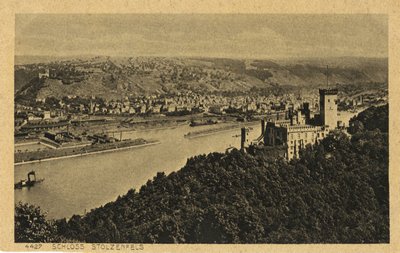 Schloss Stozenfels
Schloss Stozenfels
Arrived at Coblenz, which is a fine city lying at the mouth of the Moselle. Just opposite lay the extensive fortifications of Ehrenbreitstein castle, spread out over the top of a great mass of solid rock.
Leaving Coblenz, we crossed the Moselle and entered a low-lying plain densely cultivated. Here the line cut across the open country. About a couple of miles away to the right the river valley could be seen, with its towns and villages spread out along the foot of the hills beyond. Church steeples and chimney-stacks stuck up here and there along the valley.
Traversing the plain, we again came to rough country at Andernach. This is a very interesting town with its old stone Roman wall, and Runder Turm (Round Tower) standing guard over it. Though parts of the old wall are in ruins, it is so well preserved in places that people are still living in it, as could be seen by its small curtained windows. The town has a double-towered church of a rather heavy-looking style of architecture.
From here to Bonn the river again flowed between rugged mountainous banks. Passed through the towns of Nasnedy (?) and Brohl, with the old ruins of Hammerstein castle on top of a height opposite. Could only see part of the square tower and two round turrets of Schloss Rheineck over the brow of a mount behind the town of Nieder Breisig. A little farther on, a fine modern-looking castle with many turrets and small towers could be seen across the river. Away over to the right, some distance beyond the river, a great flat-topped mountain with precipitous sides stood up proudly above the surrounding country. The houses of Ariendorf clustered cosily under a knobby mound-like hill at the mouth of a wild rugged valley opening upon the northern shore of the river.
Crossing the small river Ahr we came in sight of Erpeler Ley, a high rocky promontory towering above the village of Erpel, on the other side of the river. From the foot of this bluff a bridge spanned the Rhine to Remagen, which was our next stopping-place. It is a fairly large town, the chief feature of interest being the Apollinariskirche, a large church with four steeples, built on the top of a rocky height just outside the town.
From here our way lay close by the water's edge until we arrived at Rolandseck, which is a very pretty little town, although it's winter-time. There is a sweet wild garden hard by the railway station, and a long narrow strip of garden running along between the railway and the river. A long wooded island divides the river into two channels here, and the scenery all around is rather charming. In the distance could be seen the mighty Siebengebirge, its various rugged height towering skywards from the water's edge. On the summit of the foremost of these mountains stand the imposing ruins of Drachenfels (Dragon-Rock), so named on account of the rock it is built on bearing a remarkable resemblance to a dragon.
As the train moved on, a series of beautiful views of these mountains and valleys with all their superb grandeur unfolded itself to our gaze. They are thickly wooded where the sides are not too precipitous for vegetation. On a spur of the Drachenfels mountain stands the Drachenburg, a castle of more modern appearance, probably built to replace the ruins of its loftier predecessor. The towns of Hounef, Rhondorf, and Konigs-winter lay spread out along the riverside at the foot of the Siebengebirge.
Passing on through Mehlem, we came to Godesberg with its old castle of the same name standing on a hill above the town. With the exception of the round tower, which still remains intact, this castle is practically all in ruins. Our next stopping-place was Bonn, which marked the end of the more picturesque and interesting stretches of the Rhine. The mountainous country gave place to level plains, across which the railway took a short cut to Cologne, which we arrived at about seven o'clock, just as darkness was setting in.
Went to the Town Major's office and got a room at the Hamburger Hof. Dinner at the club was a tediously slow occupation, the number of waiters being insufficient to cope with the work properly. Concluded the day with a stroll round the town after dinner.
Thursday, 13th. Took a walk about the town after breakfast this morning. It is amusing to see the telegraph boys and others riding the spring-wheeled bicycles that the Germans have evolved because of the scarcity of rubber. Each wheel has two rims separated from each other by a number of small spiral springs all the way round. They seem to run smoothly enough, but make plenty of noise in the process.
Went through the museum in Hansa Ring. It contains many interesting old relics, a fine collection of beautiful wrought-iron work, some very fine old carved oak furniture, including a huge wardrobe of elaborate shape and design, also a wonderful sideboard in a similar style, besides various tables, desks, and other articles, all very beautiful and profusely carved. Other rooms contained many religious relics, stained glass pottery of many varied and peculiar shapes and designs, and old pottery of a bygone age. Another room contained some small but very beautiful coloured windows.
After lunch I took a walk over the Hohenzollernbrucke to the northern bank, and back over the Hangebrucke, returning past the Rathaus, which is a very old building adorned with many statues. Bought a couple of alabaster trinket boxes at a shop in Hohestrasse, one for Mum and one for Dorothy. Also bought a couple of dozen stereoscopic views of Cologne and the Rhine and a few other places.
Went round to see Mrs. Heinze and spent a pleasant quiet evening there. It was after midnight when I got back to the hotel.
Friday, 14th. After breakfast, went down Hohestrasse and bought a stereoscope to go with the views I got yesterday. Packed my things and went to the station thinking to catch an express train back to Belgium, but, after waiting over an hour, the train at last steamed slowly in and I found to my disgust that it was a troop train. As there was no other train going today, the only thing to do was to go by it.
It was a glorious sunny day. Being a troop train, progress was naturally very slow. The country we passed through was absolutely flat for the first couple of hours, till we arrived at Duren. Thereafter we entered green undulating pasture land, with occasional manufacturing towns. At last, after a tiresome trip with many delays, we arrived at the city of Aix-la-chapelle.
The country now became rougher and more broken as we approached the Belgian frontier. Passing through several small tunnels we came into some beautiful scenery. The way lay among rugged wooded hills and steep-sided valleys, with a sweet little stream gurgling and splashing over its stony bed and winding about in a snake-like course along the foot of the hills. It was the prettiest little bit of scenery I've seen for a long time. Here and there quaint little towns and villages lay snugly tucked away in the valleys. It was all very picturesque and charming, until we had crossed the frontier and were nearing Liege.
I left the troop train at Angleur, and had not long to wait for a train to Liege. Arrived there about half-past four, and, having a couple of hours to spare before catching the express to Brussels, went for a look around the town. There appeared very little of particular interest. The houses look dirty and squalid by comparison with the Rhine towns. Nearly all of the girls to be seen were painted and artificial-looking. There was, however, a nice broad boulevard through the town. A monument to some celebrity caught my attention. It consisted of a bronze figure of the honoured man seated upon a chair on a large block of stone with a bronze lion lying at his feet, and, standing half behind him with her arm resting upon the back of his chair, a very large bronze figure of a nude. The effect was incongruous, to say the least of it. It gave one the impression of a very respectable elderly man with a naked woman standing by his side.
Left Liege by the 6.40p.m. express and arrived at Brussels about half-past nine. I found myself now in a city full of life and gaiety, but it did not appeal much to my fancy. The squalid-looking streets were crowded with people, and practically all of the women looked hideous with paint plastered on their faces. What a striking contrast from the fresh clean-looking girls of Strasburg!
Found the Australian Officers' Club, but they had no accommodation left, so I got a room at the Hotel de la Poste, and settled down for the night.
Saturday, 15th. Breakfasted at the club, and then set out to see some of the city. Went up to L'Eglise St. Gudule, a fine building of grey stone, whitened in many places by the effects of rain. This gave it a rather peculiar appearance. I found the interior simply magnificent. The roof is supported by plain massive columns of stone. There are very beautiful examples of wrought-iron gas brackets and barriers. The place is rich with an abundance of sculpture, and has a beautiful and remarkable altar of oak wonderfully carved with figures of angels and cherubs. But finest of all are the stained glass windows, beautiful beyond all description. I just stood and gazed at them in wonder. Without doubt they are by far the most beautiful windows I have ever seen.
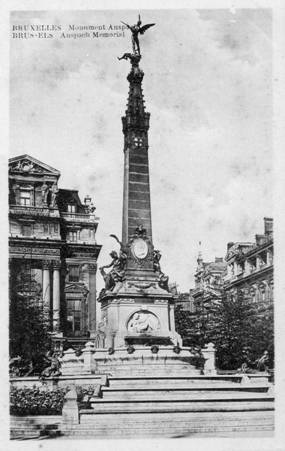
Leaving the church, I strolled up through a park, then along the Rue Royale, past a monument called the Colonne du Congres. It is a tall handsome column, with two fierce snarling lions of bronze in front, also a couple of very beautiful iron lamp-posts. Went out as far as a big square-built church with a large dome over it. Came back through the Botanical Garden, only a small one but very pretty and well laid out, with its rock-work and fountains and abundance of sculpture, mostly in bronze. A taste for the horrible is much in evidence in the sculpture here, which includes many snarling beasts, ferocious eagles, and serpents.
Came down to the Grand Place, the main square of the city, in which are the Town Hall, a striking edifice with a tall spire, and the King's house, also a fine building. Both of them are much adorned with sculpture.
After lunch at the club, I went up to the Musee des Beaux Arts, going up by the Mont des Arts, which is a garden street ascending the hill-side. It is very prettily laid out, with its many steps, rock terraces, strips of garden, and fountains, the latter forming a tiny stream down the centre when they are flowing. There were also many pieces of sculpture, a leopard crouching to spring, monster lizards, storks with serpents in their mouths, and such like, a strange combination of the beautiful and the horrible.
Arrived at the Musee, I found on the ground floor a large hall full of beautiful sculpture, but again the taste for the horrible was much in evidence. Serpents figured prominently in many of the pieces, also ferocious beasts. There was a bronze figure of a flogged negro writhing in agony, also another figure, evidently of the same negro, creeping stealthily with knife in hand and a murderous look on his face. This latter was called "Vengeance". Another piece was of a monster serpent biting a man in the neck. "Le lion amoureux" was a lovesick lion gazing benignly up into the face of a nude who was calmly clipping his claws with a pair of shears. "The Devil's Angels", and a fight between two bulls were further examples of the popular taste. There were, however, a number of very beautiful and elegant figures and groups in white marble, such as "Motherhood", "The Lovers", etc.
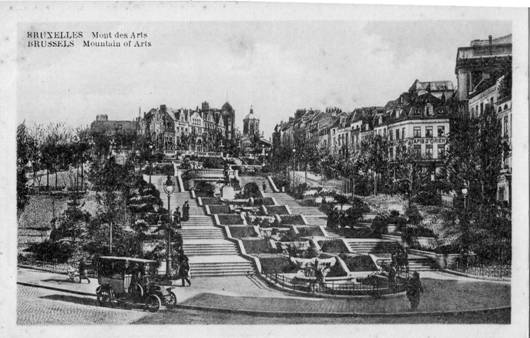 Brussels Mountain of Arts
Brussels Mountain of Arts
Went upstairs to the picture galleries. This is supposed to be a very wonderful collection, but I was rather disappointed with it. Perhaps my artistic taste is at fault. Those pictures that appeared to me most beautiful were incidentally the most horrible. One was of a murdered man sitting in a bath with a bleeding wound in his breast, writing his last message. In another fine picture a handsome youth was placidly cutting the bone out of the leg of a great strong man who was chained down, roaring in agony, and with a face of horror. In another even more horrible scene, called "The Murder of the Innocents", a number of barbarous ruffians are seen tearing little children from their mothers' arms and dashing their brains out against the stone flags of a courtyard. A remarkable feature of the collection is the number of kitchen and larder scenes. There are also a great number of symbolic and religious pictures. The Musee closed at four o'clock, before I had time to complete the tour of the galleries.
I went from there to the Palais de Justice, which is the finest building in the city. It is constructed in the Elizabethan style, and has a great central tower and dome rising high above the rest of the building. It is a grand imposing edifice occupying a high commanding position overlooking the city. Some fine panoramic views can be had from the ground around the base. Like St. Gudule, it is built of grey stone and shows the same peculiar white patchy effect of rain.
Took a tram up to the Bois de la Cambre, passing through the Avenue Louise, which is very nice and pleasant, as are all the avenues and boulevards, with their several rows of trees, promenades, little garden patches, and sculpture. Near the top of the Avenue Louise stood a stone group of a negro man and boy chained down and being attacked by two wild beasts.
Came down along the Boulevard Waterloo to the Porte de Hal, a queer ugly structure, probably some sort of a fortification in times past. Returned to the Grand Place, and, as dinner is not served at the club, I dined at the Trois Suisses Restaurant. Finished the day at a cinema, spending the last of my cash for admission. The special film was a war drama based on the tragedy of Nurse Cavell. It was a very stirring play, though the war scenes introduced were somewhat absurd. The story concluded with Edith Cavell's death being avenged by a Tommy officer whom she had helped to escape from Germany.
Sunday, 16th. Went round to the Canadian Pay Office and drew 50 francs. Finished looking through the picture galleries at the Musee des Beaux Arts. Had intended to catch the 2p.m. train to Charleroi, but missed it through going to the wrong station. Booked a seat at the Theatre Royale for the opera, and then strolled up around the Imperial Palace and park.
Dined at the Trois Suisses with another Aussie officer from Charleroi, and then we both went to the theatre together. After we had taken our seats, we were disgusted to find that it was not the opera at all, but a comedy called "Demoiselle de Magasin". It wasn't even a musical comedy. It appears there are two Theatres Royal, and of course we had come to the wrong one. The comedy looked to be a very good one, but we couldn't understand the language sufficiently to be able to follow it properly.
NEXT >>












